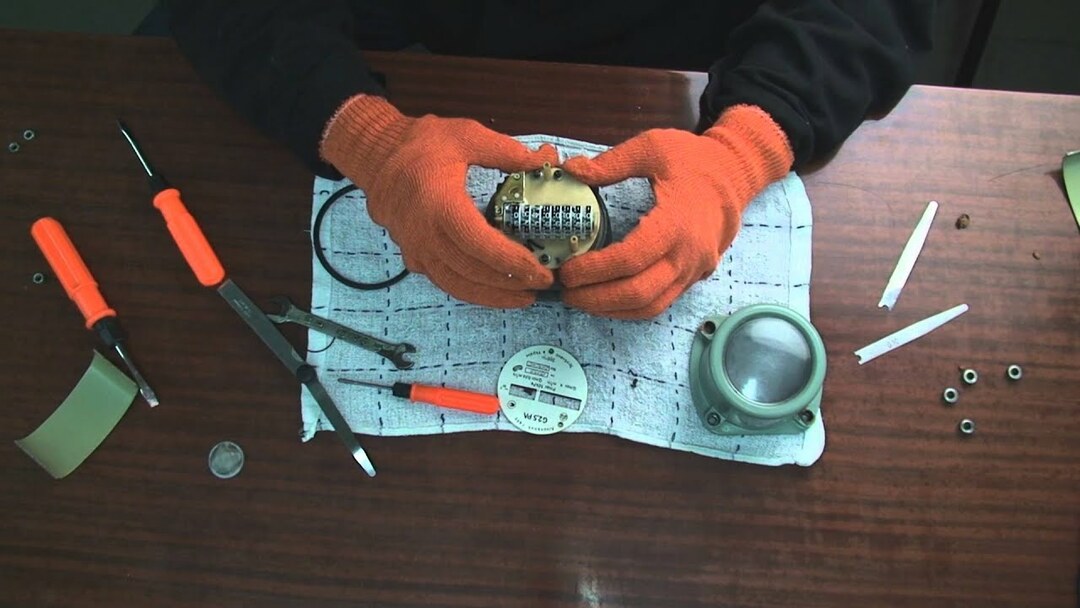Agree that every summer resident, resident of a country house at least once faced power outages. And when there is no electricity and the main gas pipeline, it is impossible to cook food and heat a residential building.
Therefore, in regions and villages where there is no gas pipeline or there are frequent power outages, gas cylinders are considered a real salvation.
For those who often use gas tanks, it is important how many cubic meters of gas are in a 50 liter cylinder, because this characteristic allows you to calculate the time and amount of work that can be done using one balloon. We analyzed the regulations governing the device and the rules for filling a typical 50 liter gas cylinders. Therefore, after reading the information below, you will decide whether or not to use a vessel with such an impressive volume.
The content of the article:
- Steel Gas Cylinder Construction
-
Dimensions and weight of 50 liter vessels
- Gas bottle capacity
- How long will a gas cylinder last?
- What kind of load can the container handle?
- Gas bottle color
- Conclusions and useful video on the topic
Steel Gas Cylinder Construction
For the transportation and storage of light hydrocarbons such as propane, propane-butane or butane, can be used composite cylinders, with a capacity of up to 47 liters.
However, the more capacious 50 liter vessels for liquefied hydrocarbons are made of steel. For storage of other liquefied or compressed gases, only steel tanks of various displacement are used.
V GOST 15860 the types, characteristics and permissible sizes of gas cylinders for hydrocarbons are described in detail. V GOST 949-73 the parameters of gas tanks suitable for operation are indicated, with an internal pressure of up to 19.6 MPa.
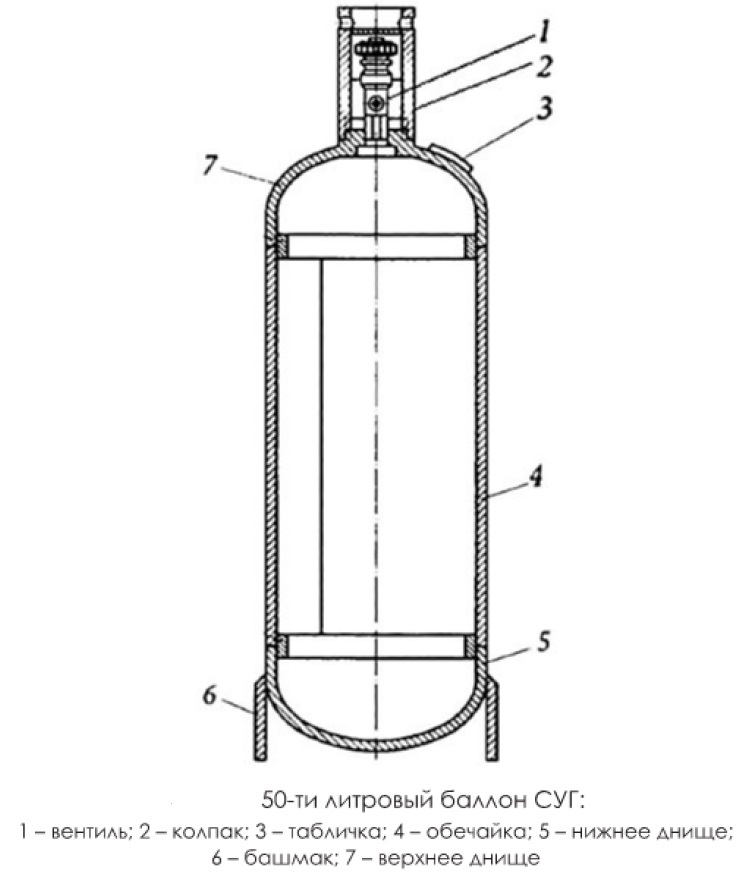
The thickness of the walls is dictated by GOSTs regulating the design of the cylinders. Blanks for steel 50 liter cylinders are seamless pipes made of steel grades: 45, 34CrMo4, 30ХМА and 30ХГСА
Both GOSTs indicate that for the safe transportation and storage of gases, each vessel must have the following structural elements:
- Support shoe.
- Body, consisting of shell, bottom, top bottom and backing ring.
- Information plate.
- Neck.
- Valve or valve.
Modifications are allowed in which a collar, handle / handles and a cap are present.
In addition to the basic standards for the manufacture of gas cylinders, there are additional standards that manufacturers must comply with.
Additional documentation includes safety rules: PB 03-576-03 "Rules for the Design and Safe Use of Pressure Vessels". They detail the requirements for valves and other accessories.
Dimensions and weight of 50 liter vessels
To determine how much an empty 50 liter gas cylinder weighs, you need to know the wall thickness and dimensions of the tank.
Since the production of gas cylinders is possible only in compliance with certain standards, all the necessary characteristics are already contained in them. According to GOST 15860, the thickness of the metal for a 50 liter gas cylinder intended for storing light hydrocarbons is 3 mm.
The standard diameter of a 50 liter cylinder in which propane or butane is transported is 299 mm. And the height of its body can vary from 840 to 1015 mm.
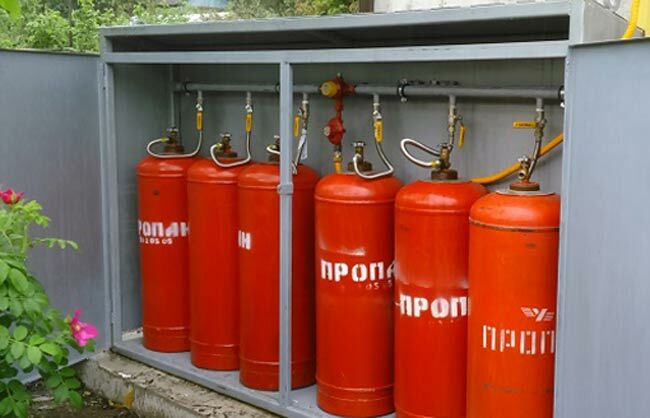
The most popular fifty-liter cylinders for carbon gases measuring 299x960 mm. Vessels for transporting gases stored under higher pressure have different characteristics reflected in GOST 949-73
The regulations for the manufacture of gas cylinders indicate that the thickness of the steel can be equal to 2.5 mm. In this case, the manufacturer must reduce the diameter of the vessel to 292 mm and increase its height. The minimum height in this case starts at 876 mm.
So, the diameter of a standard 50 liter cylinder is 29.9 cm, and the height is 93 cm. In this case, the mass of an unfilled, empty cylinder, taking into account typical shut-off valve is equal to 22 kg. At correct filling of the cylinder the required amount of gas, the weight will be set at around 43.2.
Gas bottle capacity
According to the rules of operation, a 50 liter gas cylinder can be filled with 42.5 liters of liquefied gas. This volume of contents, for a 50 liter gas cylinder, is established by the regulatory documentation, which states that for safety reasons, the container can be filled to no more than 85%.
In addition, the contents of the vessel must not be consumed to the end.
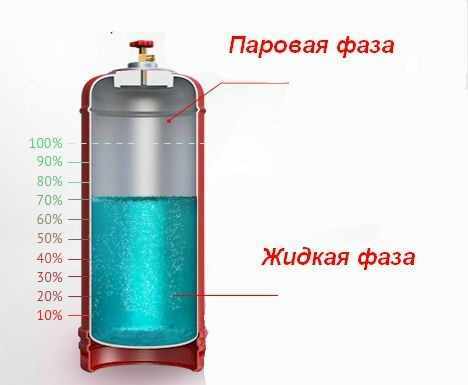
In practice, cylinder refuelers try not to take risks and often they fill the container only to 75%. Therefore, after buying a filled cylinder, 37.5 liters remain at the disposal of a summer resident or welder, which is equal to 18-19 kg
Let's try to calculate how many cubic meters of gas will be contained in a 50 liter cylinder. It is known that under standard conditions 1 kg of LPG produces 0.526 cubic meters of propane or 0.392 - butane. In this case, the percentage of the gas mixture is 60:40 (60% - propane and 40% - butane).
Let's calculate the volume of the propane-butane mixture, provided that there is 21.2 kg of gas in the cylinder:
21.2 kg • (0.526 • 0.6 + 0.392 • 0.4) = 10.01 m3
This means that a 50 liter cylinder contains approximately 10.01 cubic meters of gas.
How long will a gas cylinder last?
In order to determine for how long a filled 50 liter propane cylinder will last, you need to calculate how much gas a particular device will consume.
For example, your 4-burner stove has a gas consumption of 0.45 kg / h (this information can be found in the technical documentation for the appliance). Next, we divide the amount of gas in the cylinder by the flow rate: 21.5 / 0.45 = 47.7. This means that if you turn on all 4 burners, then the cylinder will last about 47 hours.
Of course, all four burners will not work all the time, which means that the cylinder will last for a longer period.
If it is planned to use bottled gas for heating, then its consumption can be calculated in the same way as for gas stoves. For example, let's calculate how many days a 50 liter filled cylinder will last for heating a private house, if it is known that the maximum gas consumption of a gas boiler is 1.5 kg / hour.
Before making calculations, it is worth considering that the boilers work on average for 10 hours. But, if the boiler is also supposed to be used for heating hot water, then the gas consumption increases by almost 20%.
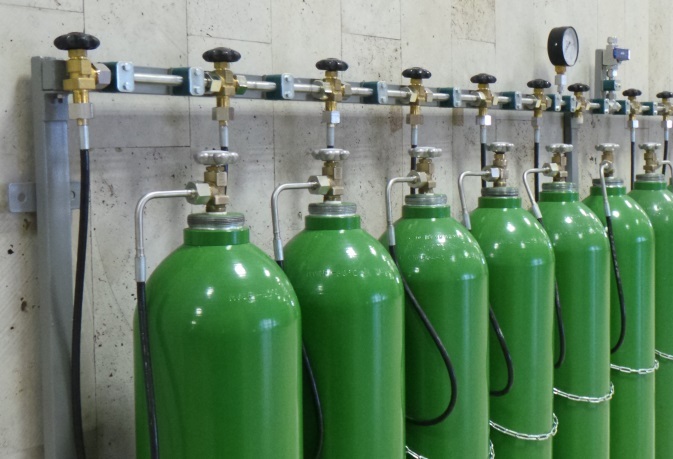
When designing an autonomous gas supply with the simultaneous connection of several cylinders, a gas train will be required. It can be used to connect up to 12 cylinders to the reducer.
We divide the mass of gas in the cylinder (21.5 kg) by its consumption (1.5 kg / h) and we get 14.3 hours. Considering that the gas boiler does not work around the clock, then a LPG cylinder can last for a maximum of 2-3 days.
In addition, it should not be forgotten that fuel consumption also depends on the degree insulation of your country house and the average daily temperature outside. So, the less the house is insulated and the lower the ambient temperature, the more the boiler will need to burn fuel in order for the room to warm up to a comfortable temperature.
The calculations made indicate that a 50 liter cylinder is not enough for a comfortable stay in a country house, especially if both the boiler and the stove consume gas. Therefore, many owners of private cottages design a gas supply system based on 3-4 50-liter gas tanks at once, which requires compliance with special conditions for their operation and storage.
What kind of load can the container handle?
Standard cylinders can withstand pressures up to 19.6 MPa. In this case, the wall thickness can be up to 8.9 mm. However, no gas distribution or consuming device can withstand such a powerful head.
The standard pressure in a 50 liter container is always 1.6 MPa. This pressure indicator is optimal for the operation of all household gearboxesto which cookers, heaters, ovens and boilers are attached.

If you follow the simple rules of operation, which include vertical storage, the installation of vessels in an iron box standing with north side, as well as the distance from wells, windows, doors and the presence of reducers, then there is no danger to the surrounding gas cylinders present
Manufacturers of standard containers are guided by a pressure of 2.5 MPa, because the vessel must withstand it during inspection, once every five years. If the seams do not stand up, the flask is immediately scrapped.
The shut-off unit must also withstand a pressure of 2.5 MPa. Although its device allows you to contain pressure up to 19.6 units. Cylinders are subjected to such a test in exceptional cases, they are mainly filled with gas with a pressure of 1.6 MPa.
Gas bottle color
In the rules PB 03-576-03, it is indicated that the outer surface of the vessels intended for the transportation of gases must be painted with the appropriate color. It depends on the type of gas that will be filled.
Red cylinders are provided for butane and other flammable gases. At the same time, for some gases, not only a color is provided, but also a corresponding color stripe.
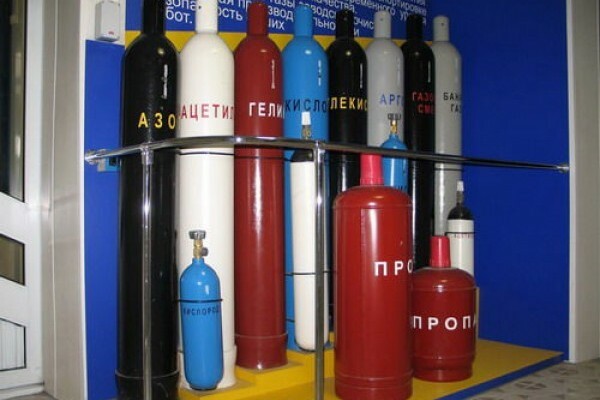
The inscriptions and stripes are applied with permanent paints and if they are erased during use, then re-application takes place at filling stations or test points. Therefore, gas cylinders always give out their content
In addition, the regulations establish a definitive inscription, which should be applied to the vessel. On the butane cylinder the word "Bhutane" should be written, on the propane cylinder "Propane". The color of the text of the inscription on the vessel with hydrocarbon gas is white. Read more about the types of gas cylinders. Further.
Conclusions and useful video on the topic
How to make a box for storing containers with gas from scrap materials in a country house:
So at filling stations, 50 liter propane cylinders are filled:
Subject to simple but mandatory safety measures, a gas cylinder in construction, metallurgy, a private house or in the country will become the most useful and irreplaceable thing.
Those who decide to use an individual gas supply system will have to solve many problems at the beginning of the design: what are the dimensions gas cylinders will be optimal 27 or 50 liters, how many containers are required for the constant functioning of the system, as well as where and how their keep. And, if you calculate the input parameters correctly, then the output will be the most perfect, uninterrupted household unit.
If you had to use 50 liter containers of gas, share: are they convenient for transportation and operation at a summer cottage? To add comments, use the form below. Ask experts questions, share your experience and current photos.

